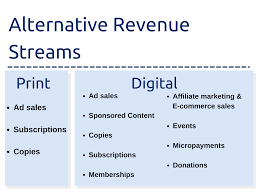Exploring Online Revenue Streams
In today’s digital age, the internet offers a plethora of opportunities for individuals and businesses to generate revenue online. From e-commerce and affiliate marketing to online courses and digital products, there are various avenues through which one can monetise their online presence. Let’s delve into some popular online revenue streams:
E-Commerce
E-commerce involves selling products or services online through a website or an online marketplace. With the rise of platforms like Shopify, WooCommerce, and Etsy, setting up an online store has never been easier. By showcasing and selling products to a global audience, businesses can tap into a vast market and drive sales.
Affiliate Marketing
Affiliate marketing is a performance-based model where individuals earn commissions by promoting other companies’ products or services. By leveraging affiliate networks like Amazon Associates or ClickBank, content creators and influencers can monetise their platforms by recommending products to their audience.
Online Courses
Creating and selling online courses has become a lucrative revenue stream for experts in various fields. Platforms like Udemy, Teachable, and Coursera allow instructors to share their knowledge with a global audience and earn money through course enrolments.
Digital Products
Digital products such as e-books, software, templates, and digital artwork offer creators an opportunity to monetise their skills and expertise. With low production costs and the ability to reach a wide audience instantly, selling digital products can be a scalable source of income.
Subscription Services
Subscription-based models have gained popularity in recent years, offering businesses recurring revenue streams. Whether it’s streaming services like Netflix, subscription boxes for niche products, or membership sites with exclusive content, subscriptions provide ongoing income while building customer loyalty.
Advertising Revenue
Monetising through advertising involves displaying ads on your website or platform in exchange for payment based on clicks (PPC) or impressions (CPM). Google AdSense, Media.net, and direct sponsorships are common ways for content creators to earn ad revenue based on their traffic volume.
In conclusion, the internet presents endless possibilities for creating diverse revenue streams online. By exploring these avenues strategically and adapting to market trends, individuals and businesses can unlock new sources of income while reaching a global audience from the comfort of their screens.
Maximising Profitability Online: The Advantages of Global Reach, Reduced Overheads, Scalability, Flexibility, and Varied Revenue Opportunities
Challenges of Digital Earnings: Navigating Competition, Algorithm Changes, Security Threats, and Income Instability
Global Reach
With online revenue streams, the significant advantage of global reach becomes evident. By leveraging the power of the internet, individuals and businesses can transcend geographical boundaries and tap into a vast audience worldwide. This expanded reach not only increases market potential but also opens up opportunities to connect with diverse demographics and cultures, ultimately fostering growth and sustainability in the digital landscape.
Low Overhead Costs
Many online revenue streams boast the significant advantage of low overhead costs, a stark comparison to the expenses typically associated with traditional brick-and-mortar businesses. This cost-effectiveness not only makes it more accessible for individuals to start their online ventures but also ensures that maintaining and scaling these enterprises remain financially viable in the long run. By minimising overhead costs, online revenue streams offer a lucrative opportunity for entrepreneurs to maximise profits and expand their digital footprint without being burdened by substantial financial commitments.
Scalability
Online revenue streams offer the distinct advantage of scalability, allowing businesses to expand their operations and accommodate growth seamlessly. Unlike traditional brick-and-mortar setups that may require substantial investments in additional resources or infrastructure to scale up, online revenue streams can be easily adjusted and expanded with minimal overhead costs. This flexibility enables businesses to capitalise on opportunities for growth efficiently and effectively, making online revenue streams a highly attractive option for those looking to expand their reach and increase their profitability in a cost-effective manner.
Flexibility
One significant advantage of online revenue streams is the flexibility they offer. With the ability to work from anywhere and at any time, individuals have the freedom to manage their online businesses on their own terms. This level of flexibility not only provides convenience but also empowers entrepreneurs to create a work-life balance that suits their needs and preferences. Whether working from a bustling coffee shop or the comfort of home, the flexibility of online revenue streams opens up a world of possibilities for those seeking autonomy in their professional endeavours.
Diverse Monetisation Options
The beauty of online revenue streams lies in the diverse monetisation options they offer. With a plethora of avenues such as e-commerce, affiliate marketing, online courses, digital products, subscription services, and advertising revenue at one’s disposal, individuals and businesses have the flexibility to diversify their income sources and experiment with different monetisation strategies. This variety not only allows for greater financial stability but also encourages creativity and innovation in how one approaches earning money online.
1. High Competition
In the realm of online revenue streams, one significant drawback is the high level of competition that saturates the digital landscape. With a multitude of businesses and individuals actively seeking to capture the attention of online consumers, standing out and attracting customers can be a daunting task. The sheer volume of competitors vying for visibility and engagement can create fierce competition, requiring strategic differentiation and innovative marketing approaches to carve out a distinct presence in an overcrowded online marketplace.
2. Dependency on Algorithms
One notable drawback of relying on online revenue streams is the inherent dependency on algorithms. Fluctuations in search engine algorithms or alterations in social media platform algorithms can have a profound impact on the visibility and traffic of a website or online business. These sudden changes can disrupt the flow of organic traffic, diminish online visibility, and ultimately affect the stability and profitability of revenue streams tied to digital platforms. It highlights the vulnerability that comes with being at the mercy of external algorithmic shifts in the dynamic online landscape.
3. Security Risks
Online revenue streams come with inherent risks, one of the most concerning being security vulnerabilities. Engaging in online transactions exposes individuals and businesses to potential cyber threats like hacking, fraud, and data breaches. These security risks not only jeopardise financial stability but also tarnish reputations. The constant need for robust cybersecurity measures is crucial to safeguard sensitive information and mitigate the impact of such threats on online revenue-generating activities.
4. Revenue Fluctuations
Online revenue streams can be susceptible to revenue fluctuations, posing a significant challenge for individuals and businesses relying on consistent income. Factors such as seasonality, shifting market trends, and external economic conditions can introduce unpredictability into online earnings. This volatility in revenue can make financial planning and stability more challenging, requiring proactive strategies to mitigate the impact of these fluctuations on overall profitability.




